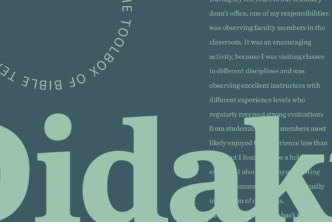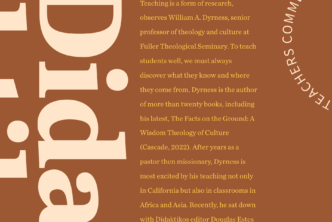by David Stark | Faulkner University
One of the most significant features of online education is its ability to deliver education to students who live away from their institutions—and, frequently, also away from each other. Significant investments in travel or relocation to study at an institution are not always viable for prospective students, especially when they intend to self-fund their educations. The risks of giving up a current job and perhaps a tuition reimbursement program can introduce meaningful downsides to traveling or relocating for school.
For prospective students with adequate Internet access, the availability of online education provides a wider array of options. Moreover, not all institutions have the same atmosphere, and online education lets prospective students explore different institutions and see whether their cultures would be a good fit.
Of course, these possibilities come with their own challenges. One of the foremost is how an institution can welcome online students as equal participants in the educational community with onground students, faculty, staff, and administrators. This challenge probably does not and cannot have a one-size-fits-all solution; the particulars of a school’s situation should inform the solution it adopts. That said, the groundwork for solving this challenge has been laid at least as far back as Thomas Aquinas.

Throughout Aquinas’s treatment of divine omnipresence, a consistent thread is his description of what presence entails and the various dimensions in which it may occur.1 Aquinas asserts that “a thing is wherever it operates,” and God is similarly present “in all things … as an agent is present to that upon which it works.”2 Divine agency is uniquely immediate, but all other agents act through some kind of medium, whether in space or with some kind of implement.3
In addition, Aquinas observes that “incorporeal things are in place not by contact of dimensive quantity, as bodies are, but by contact of power.”4 That is, physical bodies occupy space and are said to be in a particular place because they occupy that place’s space. By contrast, incorporeal entities (e.g., God, the soul) are said to be in a particular place not because they “take up space” but because they exert power within that space.5 Thus, “a king … is … in the whole kingdom by his power, although he is not everywhere present.”6 And “a thing can be said to be present to another when in its sight, though the thing may be distant in substance … therefore two modes of presence are necessary; viz., by essence, and by presence.”3
Aquinas’s analysis indicates two key elements that apply to the question of presence in online education. First, respecting their humanity, all human agents act through some medium.7 As humans interact communicatively with each other, the medium in which they do so is language—which is not simply something that can be looked up in a dictionary, but is the sphere in which hermeneutic ontology occurs.8 This linguistic mediation may occur when individuals are not physically in sight of each other (e.g., in an asynchronous online classroom). But the same kind of mediation is at play even when one individual is physically in sight of another (e.g., in an onground classroom). This observation means that even onground classes do not provide “unmediated presence.”9 Therefore, on this issue, onground and online classes stand on more equal footing than is often supposed.
[callout img=”https://files.logoscdn.com/v1/files/7113774/content.jpg?signature=iGlKALua0aT3nDDWJxdAcBnjPJk” text=”The best way to read Aquinas is on Logos and in two languages” link_url=”https://www.logos.com/product/4246/summa-theologica-english-and-latin-bundle?utm_source=academic.logos.com&utm_medium=blog&utm_content=2018-05-22-stark-online-pedagogy-didaktikos&utm_campaign=promo-logospro2018″ link_text=”Summa Theologica English and Latin Bundle”]
Second, cognitive, emotional, and social presence are incorporeal and may therefore be present through “contact of power.” For Aquinas, this phrase means something like “what may be brought about by an agent’s active use of his or her abilities.”10 In this mode, presence may involve physical proximity, but physical proximity is not necessary. One can well think of occasions when someone needs to “be there” for a friend or relative going through a difficult situation—and “being there” might take the form of a lengthy phone call or series of calls. In such cases, physical proximity is absent, but the language of “being there” recognizes that the supporting individual behaves in a way that makes himself or herself present by a non-physical mode to the individual in need of support.11
Conversely, one may sit down to dinner with one’s family and still fail to “be present” (other than in a physical sense) because of mental distractions arising from things like smartphones, problems at work, or preoccupations with future plans. In such cases, this failure renders physical presence hardly satisfactory, let alone emotionally enriching.
Thus, the thing called “presence” has different modes. For humanity, the bodily, or corporeal, mode is keenly important, and some things are accomplished only by it. But, at the same time, corporeal presence in a given locale neither guarantees nor prohibits the possibility of presence by incorporeal modes in that locale or elsewhere. Rather, incorporeal presence in its fullest form involves the kind of attention and intention that characterize “losing oneself” in play, in a book, or in conversation. Paradoxically, by thus “losing oneself,” one becomes most fully present to wherever that attention and intention are directed.12 And this presence may be communicated across a table, across a room, or across the world.

*This article first appeared in Didaktikos, the journal of Theological Education. Didaktikos is a professor-to-professor journal that covers important advances in theological education in a user-friendly format. Subscriptions to Didaktikos are free for educators in theological education, who will also receive a 20% discount on Logos Bible Software. Go here to find out more:
- Thomas Aquinas, Summa Theologica, trans. Fathers of the English Dominican Province, 22 vols. (London: Burns, Oates, and Washbourne, 1913), I.8.
- Ibid., I.8.1.
- Ibid.
- Ibid., I.8.2; see also ibid., I.8.3.
- Cf. Thomas Aquinas, A Summa of the Summa, ed. Peter Kreeft, trans. The Fathers of the English Dominican Province (San Francisco: Ignatius, 1990), 103n62.
- Aquinas, Summa, I.8.3.
- The same would be true for Jesus, with respect to his humanity but not with respect to his divinity. Cf. John of Damascus, Exposition of the Orthodox Faith, 3.13.
- Hans-Georg Gadamer, Truth and Method, 2nd ed., ed. and trans. Joel Weinsheimer and Donald G. Marshall, Bloomsbury Revelations (London: Bloomsbury Academic, 2013), 401–514.
- To some extent, this characterization runs contrary to that of Joanne J. Jung, Character Formation in Online Education: A Guide for Instructors, Administrators, and Accrediting Agencies (Grand Rapids: Zondervan, 2015), 13–14, 92. Yet, it is unclear whether this difference for Jung is simply a semantic one in which she classifies differently what are here described as the mediating role that space and spoken language have for a physically present auditor.
- See Aquinas, Summa, I.8.1, I.8.3, I.25.1; Aquinas, Summa of the Summa, 180n174.
- Cf. Aquinas, Summa of the Summa, 102n60. They come from a very different angle, but some implications of Albert Einstein’s work may also support the possibility of a broader range for a person’s “location” than is often conceived. See Aquinas, Summa of the Summa, 101n57; George Musser, Spooky Action at a Distance: The Phenomenon That Reimagines Space and Time—and What It Means for Black Holes, the Big Bang, and Theories of Everything (New York: Scientific American / Farrar, Straus, and Giroux, 2015).
- Cf. Gadamer, Truth and Method, 106–24.







